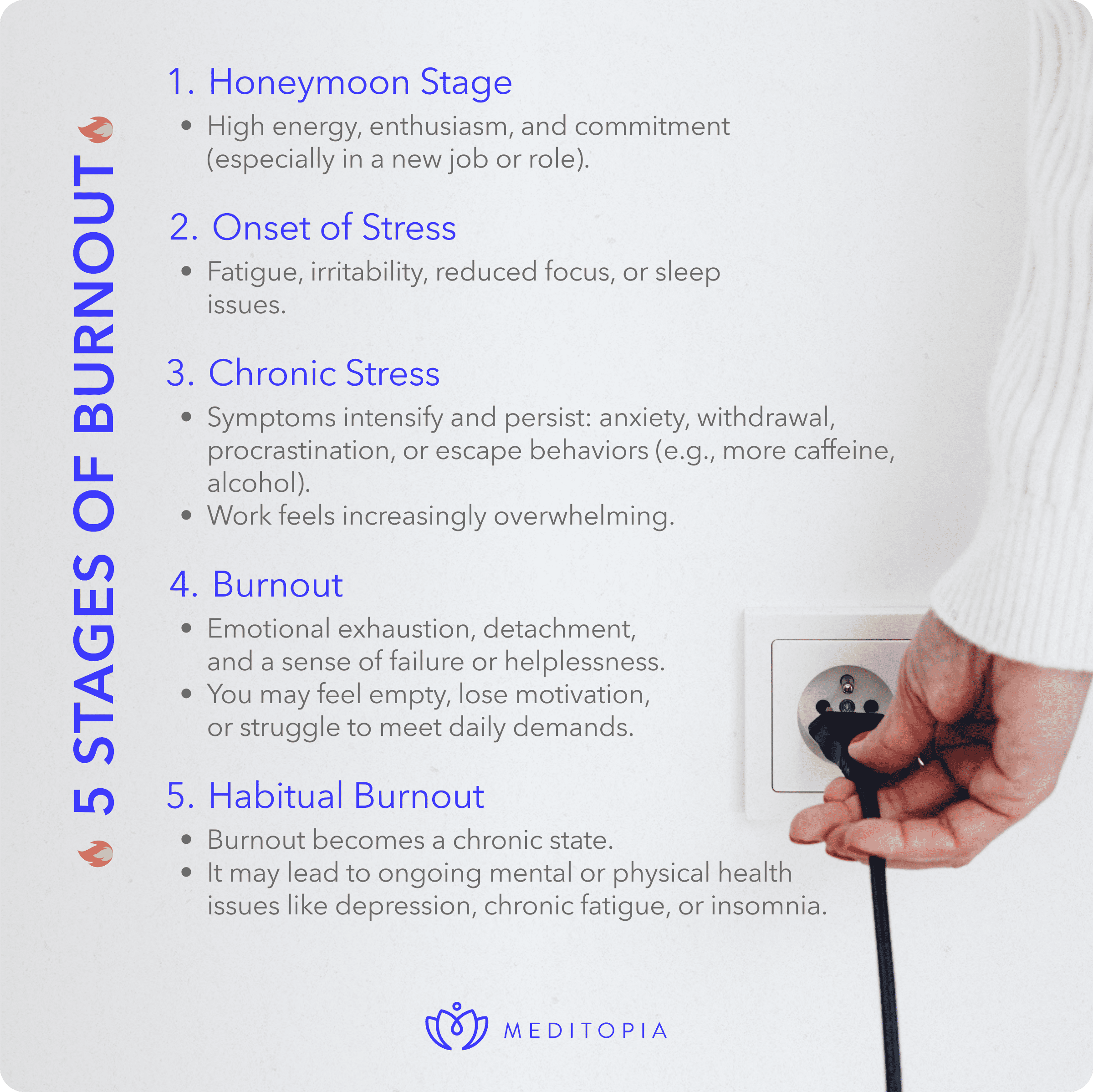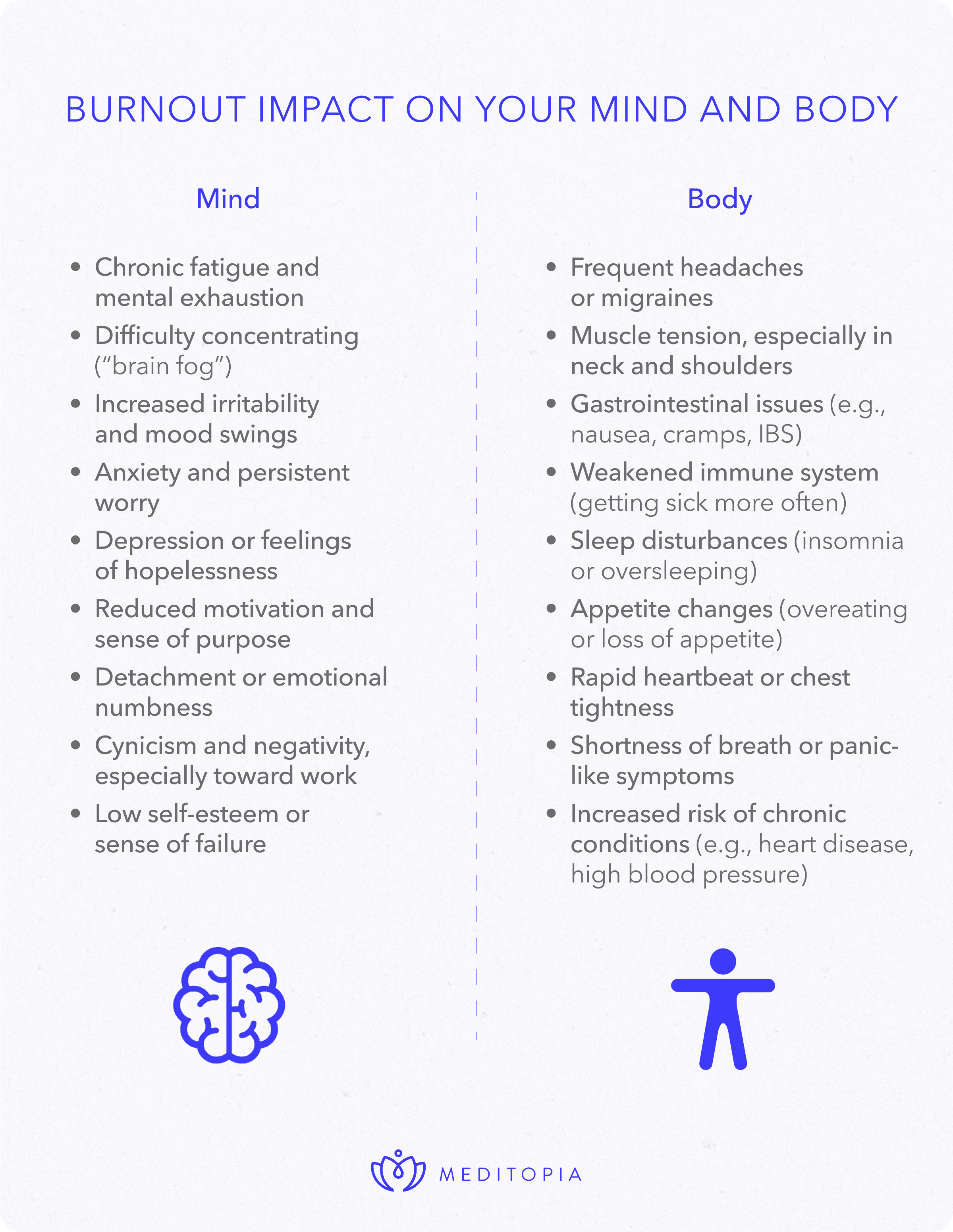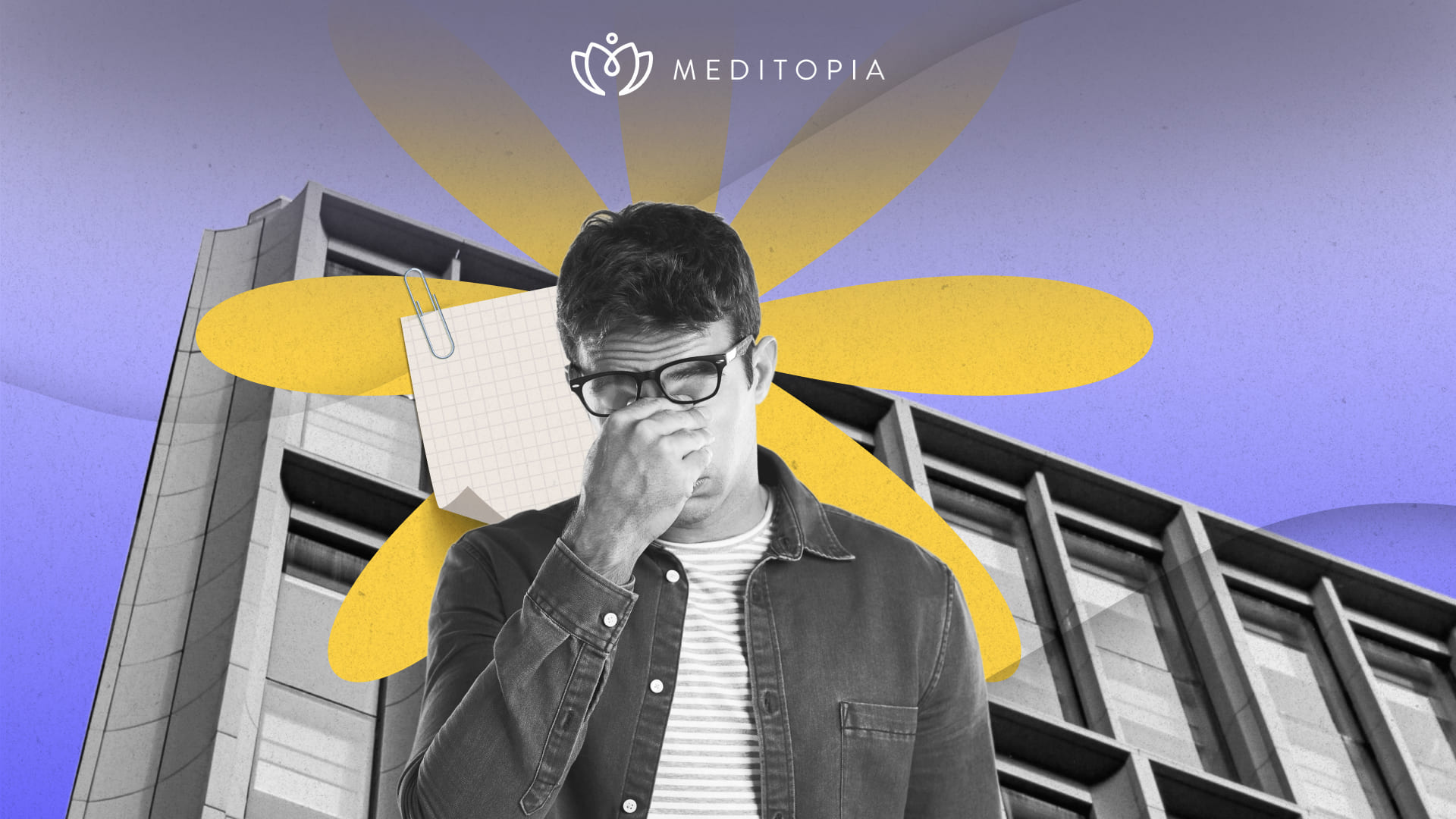Whether you're juggling a high-stress job, family responsibilities, or constant digital demands, dealing with burnout can feel like running on empty with no finish line in sight. And when quitting isn’t an option, recovery might seem even more out of reach. In this guide, we’ll explore exactly how to beat burnout without walking away from your responsibilities

What is Burnout?
Burnout is a state of emotional, mental, and physical exhaustion caused by prolonged and excessive stress, often linked to work [1]. It can leave you feeling drained, unmotivated, and detached from responsibilities. If you're dealing with burnout, recognizing the signs early is the first step toward recovery and learning how to beat burnout effectively.
Common signs of burnout include:
- Constant fatigue, even after rest
- Increased cynicism or negativity about your job
- Feeling detached or unproductive
- Difficulty concentrating
- Physical symptoms like headaches or sleep disturbances
Understanding these signs can help you take action before burnout impacts your health and career.
How to Recognize the Signs of Burnout
Burnout doesn’t always hit all at once, it builds up over time. Recognizing early signs is crucial to overcoming burnout before it deeply impacts your well-being.
Common symptoms of burnout include:
- Chronic fatigue: Feeling exhausted even after a full night’s sleep.
Example: You wake up tired and need caffeine just to get through the morning. - Emotional detachment: Becoming cynical or emotionally numb about work or daily responsibilities.
Example: You feel indifferent about tasks you once enjoyed. - Reduced performance: Struggling to concentrate, missing deadlines, or making frequent mistakes.
Example: Even simple tasks feel overwhelming, and your usual output drops significantly. - Physical symptoms: Headaches, stomach issues, or sleep disturbances.
- Irritability or mood swings: Becoming more easily frustrated or withdrawn.
According to the American Psychological Association [2], 79% of employees experienced work-related stress in the month prior to their 2021 survey, with burnout being a top consequence. It's not just you, we are all globally dealing with burnout the best way we can.
What Different Types of Burnout Are There?
Here's the thing about this condition: Itcan stem from various areas of life, not just the workplace. Understanding its different forms is essential for identifying the root causes and overcoming burnout with tailored strategies. Here are the most recognized types:
1. Job Burnout
This occurs when chronic workplace stress is not managed successfully. It’s marked by exhaustion, reduced professional efficacy, and emotional distancing from one’s job.
- Example: An employee who once thrived on deadlines now feels dread at the thought of opening their laptop.
- According to Gallup [3], 76% of employees experience burnout on the job at least sometimes.
2. Parental Burnout
Unique to caregivers, this type includes overwhelming exhaustion, emotional distancing from children, and a sense of parental ineffectiveness. You can find a specialized program to manage parenting from a mindfulness meditation perspective within Meditopia.
- Example: A parent feels constantly irritable, guilty, and disconnected from their kids.
- A 2020 study published in Clinical Psychological Science [4] found that 5–8% of parents worldwide experience severe parental burnout.
3. Caregiver Burnout
Different from parental burnout, this affects those caring for ill, elderly, or disabled loved ones. It’s emotionally draining and often leads to physical health issues in the caregiver.
- Example: A daughter caring for her elderly parent feels physically and emotionally overwhelmed, yet guilty for needing a break.
- A study in the Journal of the American Geriatrics Society [5] found 40–70% of caregivers show significant signs of burnout.
4. Compassion Fatigue
Common among healthcare professionals, therapists, and social workers, this burnout arises from prolonged exposure to others' trauma and emotional suffering.
- Example: A nurse starts feeling numb and detached after months of working in an ICU unit.
- In a survey published in the Journal of Palliative Medicine [6], over 50% of palliative care workers reported moderate to high levels of compassion fatigue.
5. Digital Burnout (or Tech Burnout)
This is one of the most common reasons why people research how to push through burnout. Constant connectivity, notifications, and screen time can lead to cognitive overload and mental fatigue, which leads to mistakes, imposter syndrome, and lack of motivation.
- Example: A remote worker juggles Slack, Zoom, emails, and social media, never mentally “off,” even after hours.
- A 2022 survey by Microsoft [7] found that 48% of employees felt digitally exhausted.
6. Academic Burnout
Seen in students and researchers, this burnout is characterized by overwhelming workload, perfectionism, and lack of motivation.
- Example: A university student studies late nights for weeks, only to feel numb and disengaged by exam day.
- According to a 2021 study in Frontiers in Psychology [8], at least 30% of students experience moderate to high academic burnout.
7. Relationship Burnout
Emotional fatigue and dissatisfaction in personal relationships can lead to detachment and chronic conflict.
- Example: A partner feels like they’re giving more than they receive, and even small issues trigger arguments.
- Psychological research shows that emotional exhaustion in romantic relationships can significantly affect well-being [9].
8. News Burnout (Media Burnout)
Constant exposure to distressing news can lead to anxiety, helplessness, and emotional numbness, a rising issue in the digital age. In fact, one of our newest mindfulness programs is to provide emotional soothing regarding news burnout. Take the assessment and listen to it today!
- Example: You scroll through social media daily to be entertained, but feel overwhelmed, sad, or powerless after each session.
- 42% of Americans actively avoid the news due to its negative emotional impact., and over 50% of U.S. adults said the news causes them stress [10].
Stages of Burnout
Burnout doesn't happen overnight. It builds up gradually, often so subtly that you may not realize how far you've progressed until you're fully exhausted. Understanding the stages of burnout can help you pause, reflect, and take action before reaching a breaking point. Here’s a commonly recognized 5-stage model:

1. Honeymoon Stage
You start a new job, project, or role with excitement and enthusiasm. Stress might be present, but you're motivated and eager to perform.
- Example: You work late voluntarily, take on extra tasks, and feel energized.
- Risk: Ignoring early signs of overwork due to passion or pressure.
2. Onset of Stress
Reality sets in. The workload increases or expectations shift. You begin to feel fatigue, anxiety, or trouble sleeping, but you may still push through.
- Example: You feel mentally overloaded or irritable, but attribute it to a "busy week."
3. Chronic Stress
Stress becomes a constant companion. You start feeling emotionally detached, miss deadlines, or notice changes in appetite or mood.
- Example: You're regularly tired, snapping at colleagues, and dreading Monday by Friday.
4. Burnout
This stage brings emotional exhaustion, cynicism, and reduced performance. You feel drained, unmotivated, and may even question your competence.
- Example: Work feels meaningless, and even simple tasks feel overwhelming.
- This is where many people finally realize they’re dealing with burnout.
5. Habitual Burnout
The condition becomes your new normal. Emotional and physical symptoms persist, and recovery may require professional support.
- Example: You feel numb, withdrawn, or hopeless, both at work and in personal life.
- This stage can lead to serious mental and physical health consequences if unaddressed.
7 Steps to Avoid Burnout
It can feel inescapable, but there are proactive steps you can take to protect your energy, regain balance, and create a healthier relationship with work and life. Below are key strategies that offer both prevention and recovery, especially if you're unable to walk away from your current responsibilities.
1. Reassess Your Workload
Taking on too much without space to recharge is one of the fastest ways to burn out. If your daily responsibilities feel unmanageable, it's time to evaluate what's truly essential.
Actionable Advice: Review your task list and identify what can be delegated, delayed, or eliminated. Set realistic boundaries with yourself and others.
Key Question: What tasks can I let go of—or say no to—without sacrificing my core responsibilities?
2. Prioritize Time Management
When you’re overwhelmed, even small tasks can feel impossible. Poor planning increases stress and reduces your capacity to focus.
Actionable Advice: Try techniques like the Pomodoro method or time blocking. Start your day by identifying the top three tasks to complete.
Key Question: Am I spending time on what matters, or just reacting to what's urgent?
3. Build in Energy Restoration
Burnout isn’t just mental, it’s also physical and emotional. Without regular energy input, you're constantly running on empty.
Actionable Advice: Incorporate micro-breaks during your day, prioritize quality sleep, and fuel your body with balanced nutrition and hydration. Take a mental health break if you need to.
Key Question: What activities refill my tank, and am I giving them enough space in my day?
4. Use Relaxation Techniques
Ongoing stress keeps your nervous system in a constant state of tension. To break the cycle, you need to activate your relaxation response regularly.
Actionable Advice: Practice simple techniques like deep breathing, progressive muscle relaxation, journaling, or guided meditation for stress, even 5 minutes can help.
Key Question: What’s one quick practice I can use today to feel more grounded?
5. Seek Professional Help
Dealing with burnout can become a severe and persistent task if left unaddressed. Speaking to a mental health professional can provide you with tools, clarity, and support to develop work-life balance.
Actionable Advice: Try not to wait until you’re in crisis. Reach out to a therapist, coach, or counselor, especially if you're feeling stuck.
Key Question: Is it time to ask for help rather than try to handle this alone?
6. Redefine Productivity
A lot of people research how to recover from burnout without quitting your job, so a mindful approach would be to redifine productivity. Since burnout often stems from tying your worth to output, pushing through without purpose can be more harmful than helpful.
Actionable Advice: Shift your mindset from doing more to doing what matters. Celebrate progress, not just perfection.
Key Question: Am I measuring success in a way that honors both my work and my well-being?
7. Make Small Changes
We understand that sometimes quitting is not a real option. In many cases, small shifts in routine, mindset, or boundaries can help you recover.
Actionable Advice: Start with one small improvement, like taking a lunch break away from your screen or setting a firm end-of-day time. Try to talk to your managers as well, together you can discuss actionable solutions.
Key Question: What’s one thing I can change this week to support my recovery? If you have tried other ways to avoid burnout before, which ones did not help?
Resources That Can Help You Overcome Burnout
While lifestyle changes can help manage burnout, sometimes you need additional support. Fortunately, there are plenty of resources (digital and offline) that offer guidance, structure, and community.
📚 Books
- Burnout: The Secret to Unlocking the Stress Cycle by Emily Nagoski & Amelia Nagoski – Offers a scientific and practical look at how stress builds and how to complete the stress cycle.
- The Joy of Burnout by Dina Glouberman – Helps reframe burnout as a wake-up call for life changes.
- Dare to Lead by Brené Brown – This is one of our favorites. It encourages vulnerability, emotional health, and values-based leadership, which can reduce work-related stress for both individuals and teams.
📱 Apps & Tools
- Meditopia, A comprehensive mental well-being app that includes guided meditations, relaxation techniques, breathing exercises, and 1:1 therapy support for individuals and companies. It is scientifically validated to help reduce stress and improve emotional resilience.

👥 Support Groups & Online Communities
- Reddit’s r/burnout and r/mentalhealth – Anonymous spaces to share experiences and get advice.
- Facebook burnout support groups – Many offer moderated peer support and live events.
- Meetup or Eventbrite – Local meetups or online circles focused on mindfulness, stress management, or career coaching.
- Try to connect with your coworkers, too! If you don't find an online support group, consider creating your own.
What Impact Does Burnout Have on Your Health?
Headaches, lack of motivation, less energy to cook healthily... All these burnout symptoms have an impact in your mental and physical health. But of course, to overcoming burnout, we need to understand its impact. Here's exactly how it can manifest:

Mental Health Effects
- Anxiety and depression: Burnout often mimics or coexists with clinical anxiety and depression [11].
- Loss of motivation and interest: Activities that once brought joy may feel meaningless.
- Emotional numbness or detachment: You may feel disconnected from your work, relationships, or even yourself.
- Irritability and mood swings: Small frustrations can trigger strong emotional reactions.
Physical Health Effects
- Chronic fatigue: Persistent tiredness that doesn’t improve with sleep [12].
- Insomnia or oversleeping: Disrupted sleep patterns, difficulty falling asleep, or waking unrefreshed.
- Increased illness: A weakened immune system can make you more vulnerable to colds, flu, or other infections.
- Headaches and muscle tension: Particularly in the neck, shoulders, and jaw.
- Digestive issues: Stomach pain, bloating, or appetite changes linked to chronic stress.
Long-Term Risks
- Cardiovascular disease: Prolonged stress and exhaustion can contribute to high blood pressure and heart issues [13].
- Type 2 diabetes: Chronic stress and poor self-care can impact blood sugar regulation.
- Cognitive decline: Memory issues, brain fog, and reduced concentration may emerge or worsen.
Please, consider that the impact of burnout on your mind and body are the same regardless of the type fo burnout your experiencing, like parental burnout or job burnout.





















